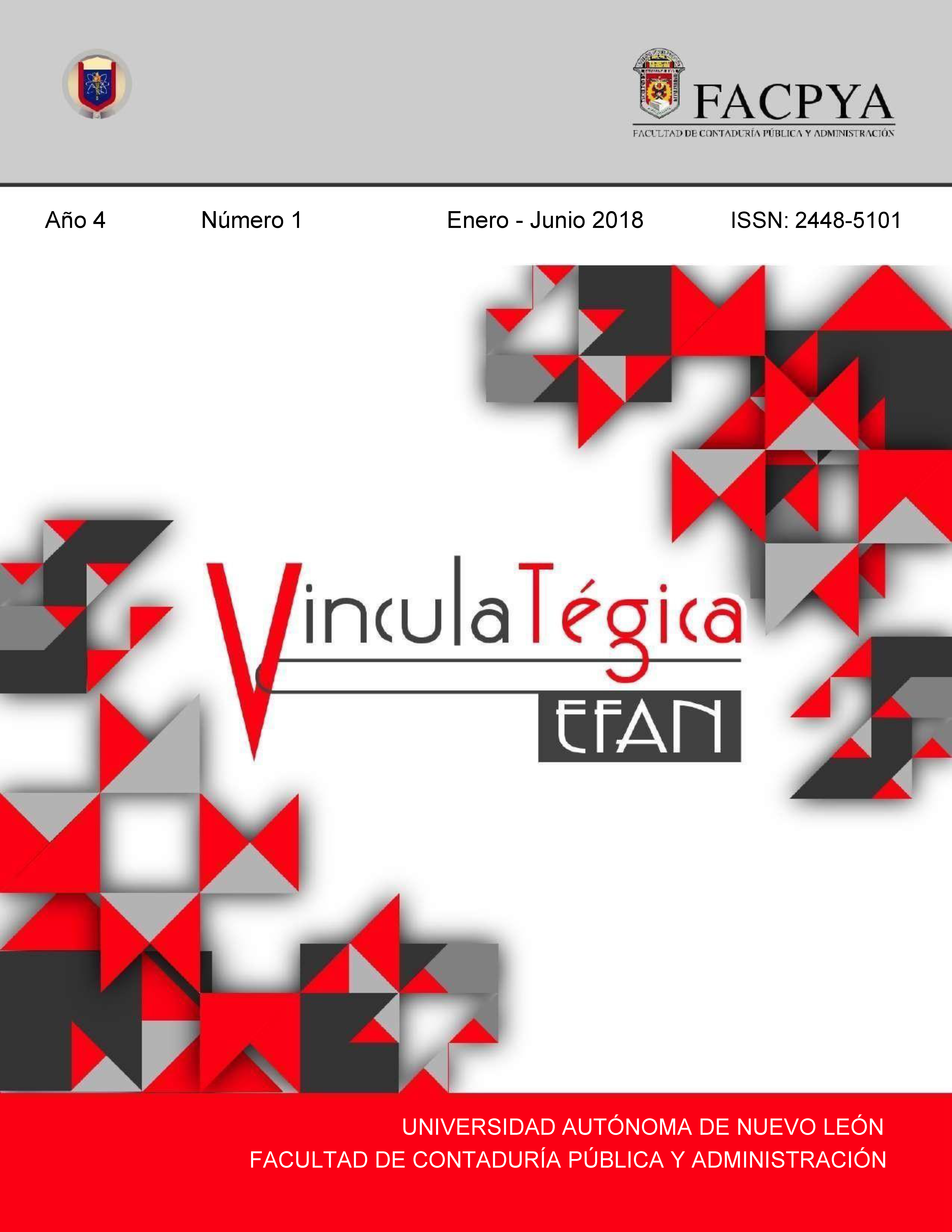Las pequeñas y medianas empresas mexicanas: 6 decisiones que toman y que elevan los costos de su internacionalización
DOI:
https://doi.org/10.29105/vtga4.1-810Keywords:
pequeña y mediana empresa, internacionalización empresarialAbstract
This paper analyses the problems that small and medium-sized Mexican companies face in the following issues : a) Registering themselves in the Tax Administration Office (SAT) performing an economic activity rather different from the real one they perform; b) abstaining from registering to the sectorial list that originally correspond to them. c) entrust the legal issues of the company to legal advisers of low cost and low performance; d) avoiding to invest in human resources that perform efficient administrative functions; e) postpone the professionalization of company managers. After reviewing each of these problems, their effects on the internationalization costs of this type of companies are analyzed.
Downloads
References
Acua, Gustavo; Bautista, Selene; Ibarra, Dario (2016). El Tratado Transpacífico. Teoría y Política. Laboratorio de Análisis Económico y Social. México D.F.
Asia-Pacific Economic Cooperation, APEC. (2015). Small and medium Enterprises. http://www.apec.org/Groups/ SOM-Steering-Committee-on-Economic-and-Techni cal-Cooperation/Working-Groups/Small-and-Medium- Enterprises.aspx
Blyde, J, A Graziano and C Volpe Martincus (2013). Economic In- tegration Agreements and Production Fragmentation: Evidence on the Extensive Margin. Inter-American De- velopment Bank, unpublished document. Washington, DC. DOI: https://doi.org/10.1080/13504851.2014.980569
Bouwen, P. (2004). Exchanging access goods for access: A com- parative study of business lobbying in the European Union institutions. European Journal of Political Re- search, 43(3), 337-369. DOI: https://doi.org/10.1111/j.1475-6765.2004.00157.x
Bundesverband der Deutschen Industrie (BDI), 2004. The Lisbon Objective: Challenges Facing Industrial SMEs in an Enlarged Europe. Policy Paper, 10. Recuperado de http:// www.bdi-online.de/dokumente/positionspapierlissabo- nengl.pdf.
Cámara de Diputados de México (2017). Ley de Comercio Exterior, http://www.diputados.gob.mx/LeyesBiblio/ref/lce.htm
Congressional Research Service, CRS. (2015). The Trans-Pacific Partnership (TPP) Negotiations and Issues for Con- gress, Washington DC.
Diehl, Paul F. (Ed.) 2005. The Politics of Global Governance. Inter- national Organizations in an Interdependent World, Boulder Colo.: Lynne Rienner.
Dür, A., & Mateo, G. (2014). “Public opinion and interest group in- fluence: how citizen groups derailed the Anti-Counter- feiting Trade Agreement. Journal of European Public Policy, 21(8), 1199-1217. DOI: https://doi.org/10.1080/13501763.2014.900893
Dür, A., & Mateo, G. (2013). Gaining access or going public? Inte- rest group strategies in five European countries. Euro- pean Journal of Political Research,52(5), 660-686. DOI: https://doi.org/10.1111/1475-6765.12012
Dür, A., & Mateo, G. (2012). Who lobbies the European Union? National interest groups in a multilevel polity. Journal of European public policy, 19(7), 969-987. DOI: https://doi.org/10.1080/13501763.2012.672103
Erramilli, M.K. & Rao, C.P. (1993). Service Firms’ International Entry-Mode Choice: A Modified Transaction-Cost Analysis Approach. Journal of Marketing, 57(3), 19-38. DOI: https://doi.org/10.1177/002224299305700302
Etemad, Hamid, (2004). Internationalization of small and medium- sized enterprises: A Grounded Theoretical Framework and an Overview. Canadian Journal of Administrative Sciences, 21; Part 1. DOI: https://doi.org/10.1111/j.1936-4490.2004.tb00319.x
Fliess Barbara, (2006). The Role of Trade Barriers in SME Interna- tionalisation. OECD Trade Policy Working Paper 45.
Frieden, J. A. (1999). Actors and preferences in international rela- tions. Strategic choice and international relations, 39-76. DOI: https://doi.org/10.1515/9780691213095-003
Gatignon, H. & Anderson, E. (1988), The Multinational Corpora- tion’s Degree of Control over Foreign Subsidiaries: An Empirical Test of a Transaction Cost Explanation. Jour- nal of Law, Economics & Organization, 4, 305-336.
Gereffi, G., Humphrey, J., & Sturgeon, T. (2005). The governance of global value chains”. Review of international political economy, 12(1), 78-104. DOI: https://doi.org/10.1080/09692290500049805
Goh, Mark, (2002). Issues Facing Asian SMEs and their Supply Chains. En Asian Cases on Supply Chain Management for SME. ed. By Dr. Mark Goh, Asia Productivity Orga- nization, Tokyo. p. 40.
Hayakawa, K y N Yamashita (2011). The Role of Preferential Trade Agreements (PTAs) en Facilitating Global Production Networks, IDE Discussion paper 280. DOI: https://doi.org/10.54648/TRAD2011042
Krist, William (2013) “The Transpacific partnership negotiations: getting to an agreement”. Woodrow Wilson International Center for Scholars. Washington DC.
Milner, H. V. (1999). The political economy of international trade. Annual Review of Political Science, 2(1), 91-114. DOI: https://doi.org/10.1146/annurev.polisci.2.1.91
Milner, H. V. (1997). Interests, institutions, and information: Do- mestic politics and international relations. Princeton University Press.
Moini, A.H. (1997). Barriers inhibiting export performance of small and medium-sized firms. Journal of Global Marketing, 10, 84. DOI: https://doi.org/10.1300/J042v10n04_05
Moravcsik, Andrew. (1997). Taking Preferences Seriously: A Libe- ral Theory of International Politics. International Organization 51 (4), 513-553. DOI: https://doi.org/10.1162/002081897550447
OECD (2006), Background Draft Report of the OECD-APEC Joint Project on “Removing Barriers to SME Access to Inter national Markets”. CFE/SME (2006)9/REV2, París.
Olsen, Johan P. (1997). El Redescubrimiento de las Instituciones. La Base Organizativa de la Política. Nuevas Lecturas de Política y Gobierno. Fondo de Cultura Económica, primera edición, México D.F.
Onuf, Nicholas. (2002) Institutions, Intentions and International Relations. Review of International Studies (28), 211-228. DOI: https://doi.org/10.1017/S0260210502002115
Rasmussen, A., Carroll, B. J., & Lowery, D. (2014). Representati- ves of the public? Public opinion and interest group activi- ty. European Journal of Political Research, 53(2), 250-268. DOI: https://doi.org/10.1111/1475-6765.12036
Requena-Silvente, Francisco (2005). The decision to enter and exit foreign markets: Evidence from U.K. SMEs. Small Busi- ness Economics 25, 237-253, 239. DOI: https://doi.org/10.1007/s11187-003-6460-x
Trampusch, C. (2014). Why preferences and institutions change: A systematic process analysis of credit rating in Germany. European Journal of Political Research, 53(2), 328-344. DOI: https://doi.org/10.1111/1475-6765.12034
Rindfleisch, A. y Heide, J.B. (1997), Transaction Cost Analysis: Past, Present, and Future Applications. Journal of Mar- keting, 61, 30-54 DOI: https://doi.org/10.1177/002224299706100403
Traxler, F. (2005). Firm size; SMEs and business associations: A European Comparison. Small and medium sized enter- prises and Business Interest Organisations in the Euro- pean Union, 300.
Vogel, S. K. (1999). When interests are not preferences: The cau- tionary tale of Japanese consumers. Comparative Poli- tics, 187-207. DOI: https://doi.org/10.2307/422144
Williamson, O.E. (1985). The Economic Institutions of Capitalism. New York, The Free Press.
Whyte, Garth. (2005). Should SMEs be at the International Policy Table? Lessons learned in North America. Presentado en Congreso Internacional de PyMEs 2005.
Woll, C. (2009). Firm interests: How governments shape business lobbying on global trade. Cornell University Press. DOI: https://doi.org/10.7591/9781501711497
Downloads
Published
How to Cite
Issue
Section
License

This work is licensed under a Creative Commons Attribution 4.0 International License.
a). Authors keep copyright and give the journal the right of the first publication of the work under a Creative Commons attribution license. This license allows others to share the work as long as original authorship and initial publication in this journal is acknowledged.
b). Authors may make other independent and additional contractual agreements for the non-exclusive distribution of the version of the article published in this journal (e.g., include it in an institutional repository or publish it in a book) as long as they clearly indicate that the work was published for the first time in this journal.







